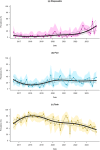Disposable e-cigarettes: Prevalence of use in Germany from 2016 to 2023 and associated user characteristics
- PMID: 39488907
- PMCID: PMC11813731
- DOI: 10.1111/add.16675
Disposable e-cigarettes: Prevalence of use in Germany from 2016 to 2023 and associated user characteristics
Abstract
Aims: To provide data on prevalence and trends in the use of different types of e-cigarettes (disposable, pod, tank) in Germany (a country with high smoking prevalence of approximately 30%) from 2016 to 2023, and to analyse the characteristics and smoking behaviours of users of these types.
Design: A series of nationally representative cross-sectional face-to-face household surveys.
Setting: General population of Germany, 2016-2023.
Participants: A total of 92 327 people (aged ≥14 years) of which 1398 reported current use of e-cigarettes.
Measurements: Type of e-cigarette usually used (single choice: disposable, pod, or tank), person characteristics, and smoking/vaping behaviour.
Findings: E-cigarette use in the population of Germany has increased from 1.6% (95% confidence interval [CI] = 1.1,2.2) in 2016 to 2.2% (95% CI = 1.6,3.0) at the end of 2023. Disposable e-cigarette use has increased in this period from 0.1% (95% CI = 0.0,0.3) to 0.8% (95% CI = 0.4,1.8). Pod type use exhibited the most stable trend, with a steady rise to 0.6% (95% CI = 0.4,0.9) in 2023. Tank e-cigarette use peaked at 1.6% (95% CI = 1.3,1.9) in November 2017, declined to 0.7% (95% CI = 0.6,0.9) in December 2020, and has since remained constant at 0.8% (95% CI = 0.6,1.0). Disposable e-cigarette users were on average 3.5 and 4.1 years younger than tank and pod users, respectively. They were more likely than tank users to be female, non-daily users, and dual users of tobacco. In the subgroup of dual users, there were no significant differences with regard to urges to smoke, cigarettes smoked per day, motivation to stop, and attempts to stop smoking between users of disposables and other types.
Conclusions: The use of e-cigarettes has increased in Germany from 2016 to 2023, especially that of disposable e-cigarettes, which are now the most commonly used type with a prevalence rate of 0.8%. However, the use of e-cigarettes is still much lower compared with tobacco smoking.
Keywords: Germany; disposable; e‐cigarettes; population survey; tobacco smokers; trends.
© 2024 The Author(s). Addiction published by John Wiley & Sons Ltd on behalf of Society for the Study of Addiction.
Conflict of interest statement
None to declare.
Figures
References
-
- Schaller K, Kahnert S, Graen L, Mons U, Ouédraogo N. Tobacco Atlas [Tabakatlas] Deutschland 2020 [Internet]. 1. Auflage. Deutsches Krebsforschungszentrum, editor Lengerich: Pabst Science Publishers; 2020. Retrieved 01.12.2022 from: https://www.dkfz.de/de/tabakkontrolle/download/Publikationen/sonstVeroef....
-
- National Academies of science engineering and medicine (NASEM) . Public health consequences of E‐cigarettes Washington, DC: The National Academies Press; 2018.
-
- Centers for Disease Control and Prevention (CDC) . E‐cigarette, or vaping, products visual dictionary [Internet] U.S. Department of Health and Human Services; 2019. Retrieved 02.10.2023 from: https://www.cdc.gov/tobacco/basic_information/e-cigarettes/pdfs/ecigaret....
-
- McNeill A, Simonavicius E, Brose L, Taylor E, East K, Zuikova E, et al. Nicotine vaping in England: an evidence update including health risks and perceptions, September 2022 [internet] London: Office for Health Improvement and Disparities; 2022. p. 1468 Retrieved 20.04.2024 from: https://assets.publishing.service.gov.uk/government/uploads/system/uploa....
MeSH terms
LinkOut - more resources
Full Text Sources
Medical




